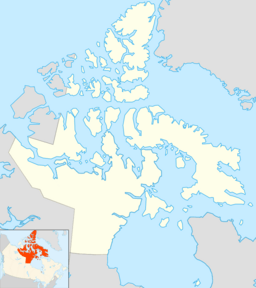Ferguson Lake (Kivalliq Region) facts for kids
Quick facts for kids Ferguson Lake |
|
|---|---|
| Location | Kivalliq Region, Nunavut |
| Coordinates | 62°54′46″N 96°53′29″W / 62.91278°N 96.89139°W |
| Primary outflows | Ferguson River |
| Basin countries | Canada |
| Max. length | 17 mi (27 km) |
| Max. width | 3 mi (4.8 km) |
| Surface elevation | 114 m (374 ft) |
| Islands | several |
| Settlements | uninhabited |
Ferguson Lake is a large lake located in the Kivalliq Region of Nunavut, Canada. It sits about 150 kilometers (93 miles) north of the "tree line," which is where trees stop growing. You can find it between two other big lakes: Yathkyed Lake and Qamanirjuaq Lake. Water from Ferguson Lake flows east into the Ferguson River. This river then travels through several other lakes before emptying into the northwestern part of Hudson Bay. The closest community to the lake is Baker Lake, which is about 160 kilometers (100 miles) to the north.
Contents
Discovery of Ferguson Lake
The lake was first explored in 1894 by a Canadian expedition. This group was led by Joseph Tyrrell, a famous explorer from the Geological Survey of Canada. A Scottish sportsman named Robert Monro Ferguson was also part of the team. The lake and the river flowing from it were named after him.
Geography of Ferguson Lake
Ferguson Lake has a very interesting and uneven shape. It features deep bays and long points of land. You can also find grassy slopes and terraces made of sand and gravel. Some parts of the lake are rocky and narrow.
There are several islands in the lake. These islands are made of gray gneiss and dark-green diorite rock. One island is large enough to have a small airstrip. East of the lake, there's a noticeable landmark called Uligattalik Hill 62°55′40″N 96°34′19″W / 62.92778°N 96.57194°W. The lake is part of the Canadian Shield, which is a very old and rocky part of Canada.
Flora: Plants Around the Lake
The plants that grow around Ferguson Lake are well-suited to the cold climate. You'll mostly find dwarf birch shrubs and Labrador tea plants. There are also many types of lichen and moss covering the ground.
Fauna: Animals of Ferguson Lake
The cold, subarctic weather and the open, treeless land around the lake are home to many animals. You might see barren-ground caribou, grizzly bears, and muskoxen. Other animals include Arctic hares and Arctic foxes. The lake itself is home to fish like searun Arctic char.
Mineral Exploration Near Ferguson Lake
People have been looking for valuable minerals around Ferguson Lake for many years. This process is called mineral exploration.
History of Mineral Discoveries
In 1953, explorers found copper and nickel in the area. Later, in 1987, they discovered cobalt, palladium, and platinum. These are all valuable metals. A company called Starfield Resources started drilling in 1999 to find more of these minerals.
Current Exploration Projects
In 2004, commercial drilling began on the east side of the lake. This was part of a large project to find more nickel, copper, cobalt, platinum, and palladium. By 2007, Starfield's exploration 62°55′00″N 97°00′00″W / 62.91667°N 97.00000°W became very important. It had the potential to become Nunavut's biggest project for finding base metals and precious metals. Some of this research even gets funding from McGill University.
In early 2007, local groups shared their concerns about the project. The Ferguson Lake Inuit, who now live in Baker Lake, asked for reports and wanted to be involved in planning. They wanted to make sure that important archaeological, cultural, or traditional sites around the lake were protected. The Beverly and Qamanirjuaq Caribou Management Board also spoke up. They were concerned about the impact on the area's caribou population.
In March 2008, Starfield announced they found signs of rhodium, which is a very valuable metal. The company's CEO, André Douchane, said they would continue to focus on the Ferguson Lake site. A week later, Starfield announced that their studies showed the project could be very successful and profitable. They believe there are enough minerals like cobalt, copper, and nickel to keep operations going until 2030. The plan includes digging an open pit mine first, then an underground mine. They also plan to build a processing plant on site. A special pipeline would carry the processed minerals to Rankin Inlet, where they would be loaded onto ships.


